Research on Micro-Displacement Measurement Accuracy Enhancement Method Based on Ensemble NV Color Center
Abstract
:1. Introduction
2. Materials and Methods
3. Results and Discussion
4. Conclusions
Author Contributions
Funding
Institutional Review Board Statement
Informed Consent Statement
Data Availability Statement
Conflicts of Interest
References
- Parali, L.; Pechousek, J.; Şabikoğlu, I.; Novak, P.; Navarik, J.; Vujtek, M. A digital measurement system based on laser displacement sensor for piezoelectric ceramic discs vibration characterization. Optik 2016, 127, 84–89. [Google Scholar] [CrossRef]
- Braunsmann, C.; Proksch, R.; Revenko, I.; Schäffer, T.E. Creep compliance mapping by atomic force microscopy. Polymer 2014, 55, 219–225. [Google Scholar] [CrossRef]
- Jiang, C.-S.; Repins, I.; Beall, C.; Moutinho, H.; Ramanathan, K.; Al-Jassim, M. Investigation of micro-electrical properties of Cu2ZnSnSe4 thin films using scanning probe microscopy. Sol. Energy Mater. Sol. Cells 2015, 132, 342–347. [Google Scholar] [CrossRef]
- Wang, C.; Xu, L.-L.; Zhu, J.; Yuan, Z.-W.; Yu, Y.-J.; Asundi, A.K. A novel integrated fiber-optic interferometer model and its application in micro-displacement measurement. Opt. Lasers Eng. 2016, 86, 125–131. [Google Scholar] [CrossRef]
- Li, X.; Wang, R.; Du, H.; Lu, Y. Three-dimensional micro-displacement measurement method based on capacitance-grating sensor. Measurement 2021, 187, 110179. [Google Scholar] [CrossRef]
- Zhao, R.; Li, X.; Sun, P.; Tang, Y.; Jiao, P.; Huang, Y.; Jia, J. Image Spherizing-Based Three-Dimensional Displacement Measurement Technique for Microscope with Single Camera. Photonics 2022, 9, 148. [Google Scholar] [CrossRef]
- Liu, Y.-T.; Li, B.-J. A 3-axis precision positioning device using PZT actuators with low interference motions. Precis. Eng. 2016, 46, 118–128. [Google Scholar] [CrossRef]
- Peng, Y.; Ito, S.; Shimizu, Y.; Azuma, T.; Gao, W.; Niwa, E. A Cr-N thin film displacement sensor for precision positioning of a micro-stage. Sens. Actuators A-Phys. 2014, 211, 89–97. [Google Scholar] [CrossRef]
- Doherty, M.W.; Manson, N.B.; Delaney, P.; Jelezko, F.; Wrachtrup, J.; Hollenberg, L.C. The nitrogen-vacancy colour centre in diamond. Phys. Rep.-Rev. Sec. Phys. Lett. 2013, 528, 1–45. [Google Scholar] [CrossRef]
- Suter, D.; Jelezko, F. Single-spin magnetic resonance in the nitrogen-vacancy center of diamond. Prog. Nucl. Magn. Reson. Spectrosc. 2017, 98-99, 50–62. [Google Scholar] [CrossRef]
- Luo, M.-X.; Li, H.-R.; Lai, H.; Wang, X. Quantum Computation Based on Photons with Three Degrees of Freedom. Sci. Rep. 2016, 6, 25977. [Google Scholar] [CrossRef] [PubMed]
- Doherty, M.W.; Acosta, V.M.; Jarmola, A.; Barson, M.S.; Manson, N.B.; Budker, D.; Hollenberg, L.C. Temperature shifts of the resonances of the NV-center in diamond. Phys. Rev. B 2014, 90, 5. [Google Scholar] [CrossRef]
- Zhang, C.; Yuan, H.; Zhang, N.; Xu, L.; Zhang, J.; Li, B.; Fang, J. Vector magnetometer based on synchronous manipulation of nitrogen-vacancy centers in all crystal directions. J. Phys. D-Appl. Phys. 2018, 51, 12. [Google Scholar] [CrossRef]
- Zhao, M.; Lin, Q.; Zhu, L.; Zhao, L.; Jiang, Z. Antenna for microwave manipulation of NV colour centres. Micro Nano Lett. 2020, 15, 793–796. [Google Scholar] [CrossRef]
- Backlund, M.P.; Kehayias, P.; Walsworth, R.L. Diamond-Based Magnetic Imaging with Fourier Optical Processing. Phys. Rev. Appl. 2017, 8, 11. [Google Scholar] [CrossRef]
- Rondin, L.; Tetienne, J.-P.; Hingant, T.; Roch, J.-F.; Maletinsky, P.; Jacques, V. Magnetometry with nitrogen-vacancy defects in diamond. Rep. Prog. Phys. 2014, 77, 26. [Google Scholar] [CrossRef]
- Freeman, M.R.; Choi, B.C. Advances in Magnetic Microscopy. Science 2001, 294, 1484–1488. [Google Scholar] [CrossRef]
- Blakley, S.M.; Fedotov, I.V.; Amitonova, L.V.; Serebryannikov, E.E.; Perez, H.; Kilin, S.Y.; Zheltikov, A.M. Fiber-optic vectorial magnetic-field gradiometry by a spatiotemporal differential optical detection of magnetic resonance in nitrogen-vacancy centers in diamond. Opt. Lett. 2016, 41, 2057–2060. [Google Scholar] [CrossRef]
- Nie, Y.; Huang, K.; Cheng, L.; Cui, J.; Li, J.; Heng, L. Manipulation of Spin Polarization Using NV Ensemble in Diamond for Precision Displacement Detection with an Adjustable Sensitivity. IEEE Sens. J. 2020, 21, 5961–5966. [Google Scholar] [CrossRef]
- Fescenko, I.; Jarmola, A.; Savukov, I.; Kehayias, P.; Smits, J.; Damron, J.; Ristoff, N.; Mosavian, N.; Acosta, V.M. Diamond magnetometer enhanced by ferrite flux concentrators. Phys. Rev. Res. 2020, 2, 023394. [Google Scholar] [CrossRef]
- Leroy, P.; Coillot, C.; Roux, A.; Chanteur, G. High magnetic field amplification for improving the sensitivity of Hall sensors. IEEE Sens. J. 2006, 6, 707–713. [Google Scholar] [CrossRef]
- Wang, L.; Guo, H.; Chen, Y.-L.; Wu, D.-J.; Zhao, R.; Liu, W.-Y.; Li, C.-M.; Xia, M.-J.; Zhao, B.-B.; Zhu, Q.; et al. A method of measuring micro-displacement based on spin magnetic resonance effect of diamond color center. Acta Phys. Sin. 2018, 67, 8. [Google Scholar] [CrossRef]
- Wang, X.; Zheng, D.; Wang, X.; Liu, X.; Wang, Q.; Zhao, J.; Guo, H.; Qin, L.; Tang, J.; Ma, Z.; et al. Portable Diamond NV Magnetometer Head Integrated with 520 nm Diode Laser. IEEE Sens. J. 2022, 22, 5580–5587. [Google Scholar] [CrossRef]
- Fu, K.-M.; Santori, C.; Barclay, P.; Beausoleil, R.G. Conversion of neutral nitrogen-vacancy centers to negatively charged nitrogen-vacancy centers through selective oxidation. Appl. Phys. Lett. 2010, 96, 3. [Google Scholar] [CrossRef]
- Bluvstein, D.; Zhang, Z.; Jayich, A.C.B. Identifying and Mitigating Charge Instabilities in Shallow Diamond Nitrogen-Vacancy Centers. Phys. Rev. Lett. 2019, 122, 7. [Google Scholar] [CrossRef]
- Ma, Y.; Rohlfing, M.; Gali, A. Excited states of the negatively charged nitrogen-vacancy color center in diamond. Phys. Rev. B 2010, 81, 4. [Google Scholar] [CrossRef]
- Zhang, N.; Zhang, C.; Xu, L.; Ding, M.; Quan, W.; Tang, Z.; Yuan, H. Microwave Magnetic Field Coupling with Nitrogen-Vacancy Center Ensembles in Diamond with High Homogeneity. Appl. Magn. Reson. 2016, 47, 589–599. [Google Scholar] [CrossRef]
- Wang, C.J.; Shi, F.Z.; Wang, P.F.; Duan, C.K.; Du, J.F. Nanoscale magnetic field sensing and imaging based on nitrogen-vacancy center in diamond. Acta Phys. Sin. 2018, 67, 9. [Google Scholar]
- Liu, D.Q.; Chang, Y.C.; Liu, G.Q.; Pan, X.Y. Electron spin studies of nitrogen vacancy centers in nanodiamonds. Acta Phys. Sin. 2013, 62, 5. [Google Scholar]
- Matsuzaki, Y.; Shimo-Oka, T.; Tanaka, H.; Tokura, Y.; Semba, K.; Mizuochi, N. Hybrid quantum magnetic-field sensor with an electron spin and a nuclear spin in diamond. Phys. Rev. A 2016, 94, 6. [Google Scholar] [CrossRef]
- Balasubramanian, G.; Chan, I.Y.; Kolesov, R.; Al-Hmoud, M.; Tisler, J.; Shin, C.; Kim, C.; Wojcik, A.; Hemmer, P.R.; Krueger, A.; et al. Nanoscale imaging magnetometry with diamond spins under ambient conditions. Nature 2008, 455, 648–651. [Google Scholar] [CrossRef] [PubMed]
- Doherty, M.W.; Dolde, F.; Fedder, H.; Jelezko, F.; Wrachtrup, J.; Manson, N.B.; Hollenberg, L.C.L. Theory of the ground-state spin of the NV− center in diamond. Phys. Rev. B 2012, 85, 21. [Google Scholar] [CrossRef]
- Vagin, D.V.; Gerasimenko, T.N.; Polyakov, P.A. Exact analytical expression for magnetic field induction of rectangular shape sample. Mosc. Univ. Phys. Bull. 2008, 63, 422–424. [Google Scholar] [CrossRef]
- Li, Z.-H.; Wang, T.-Y.; Guo, Q.; Guo, H.; Wen, H.-F.; Tang, J.; Liu, J. Enhancement of magnetic detection by ensemble NV color center based on magnetic flux concentration effect. Acta Phys. Sin. 2021, 70. [Google Scholar] [CrossRef]
- Ma, J.; Yang, W.M.; Li, J.W.; Wang, M.; Chen, S.L. The effects of magnetization methods with additional permanent magnet on the magnetic field distribution and levitation force of single domain GdBCO bulk superconductor. Acta Phys. Sin. 2012, 61, 6. [Google Scholar]
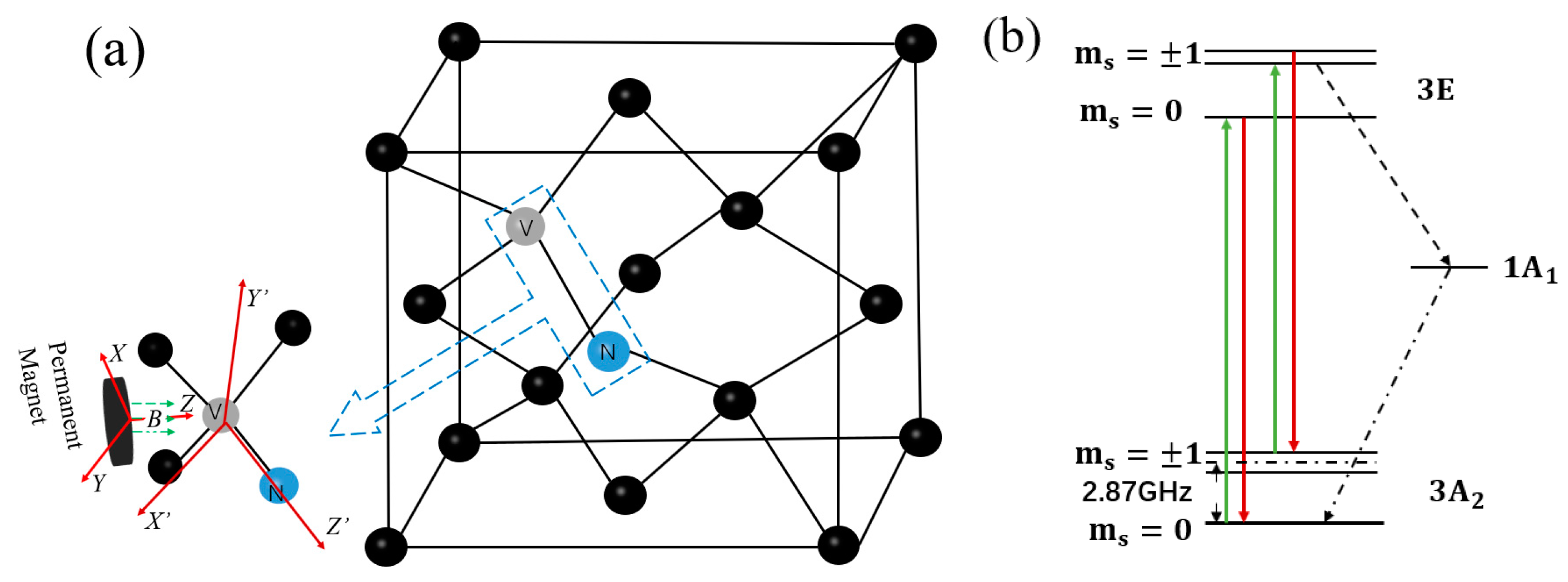
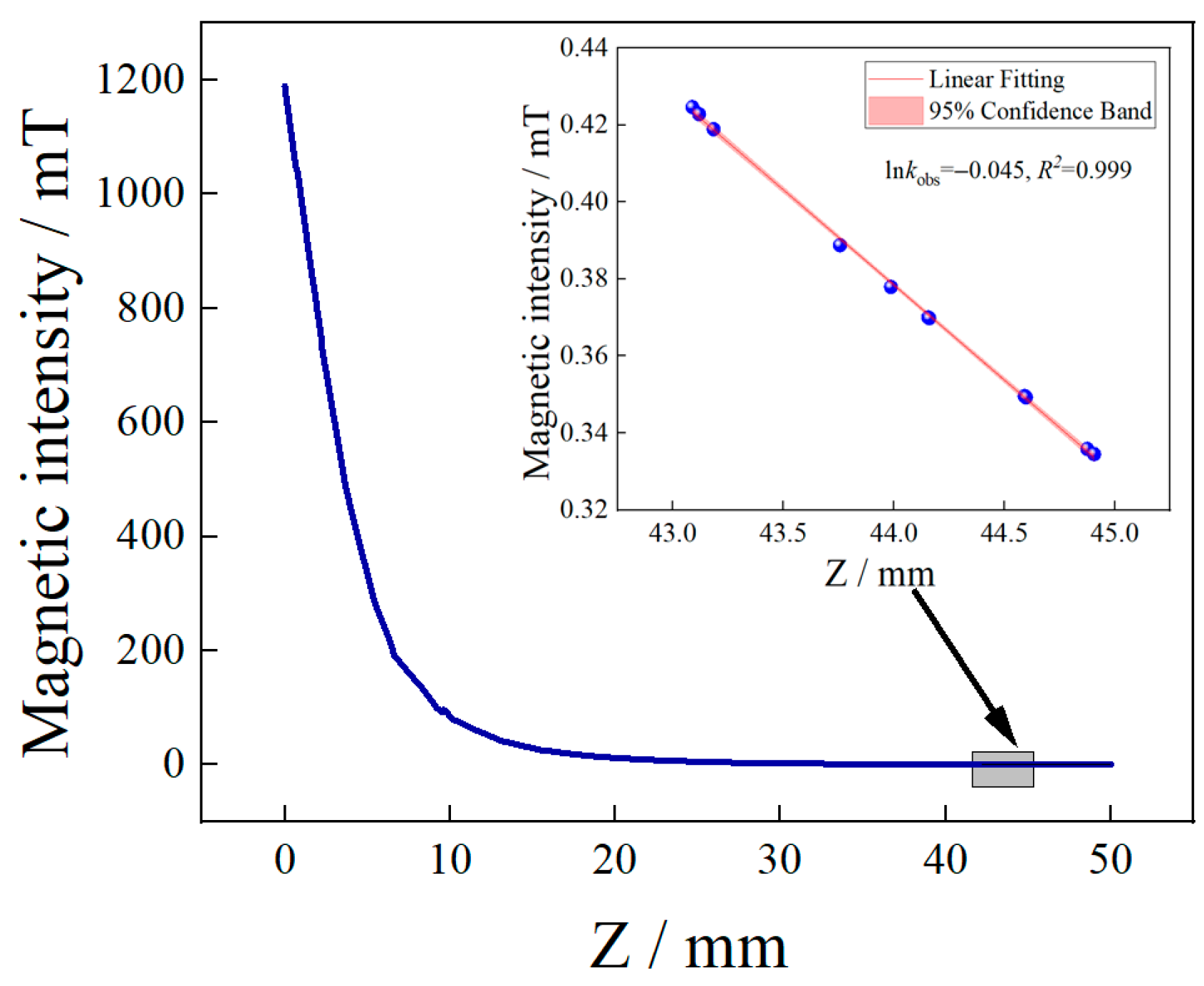
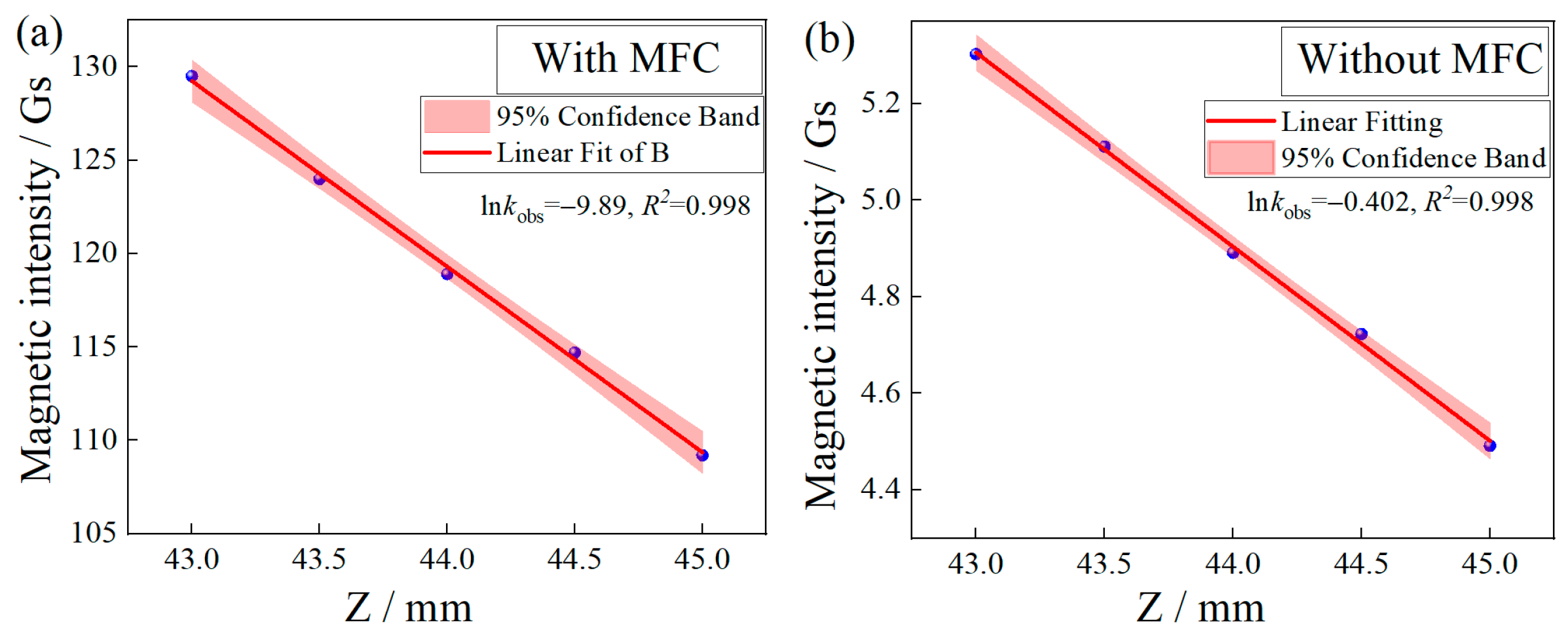

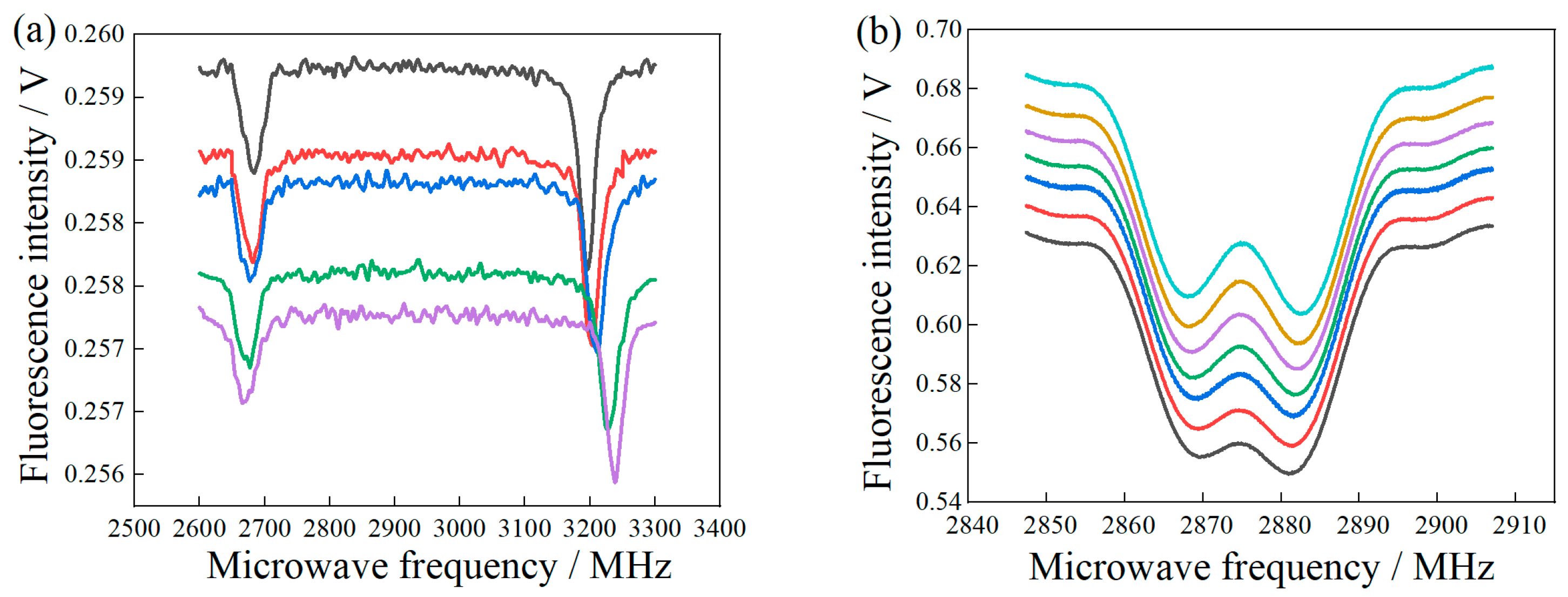

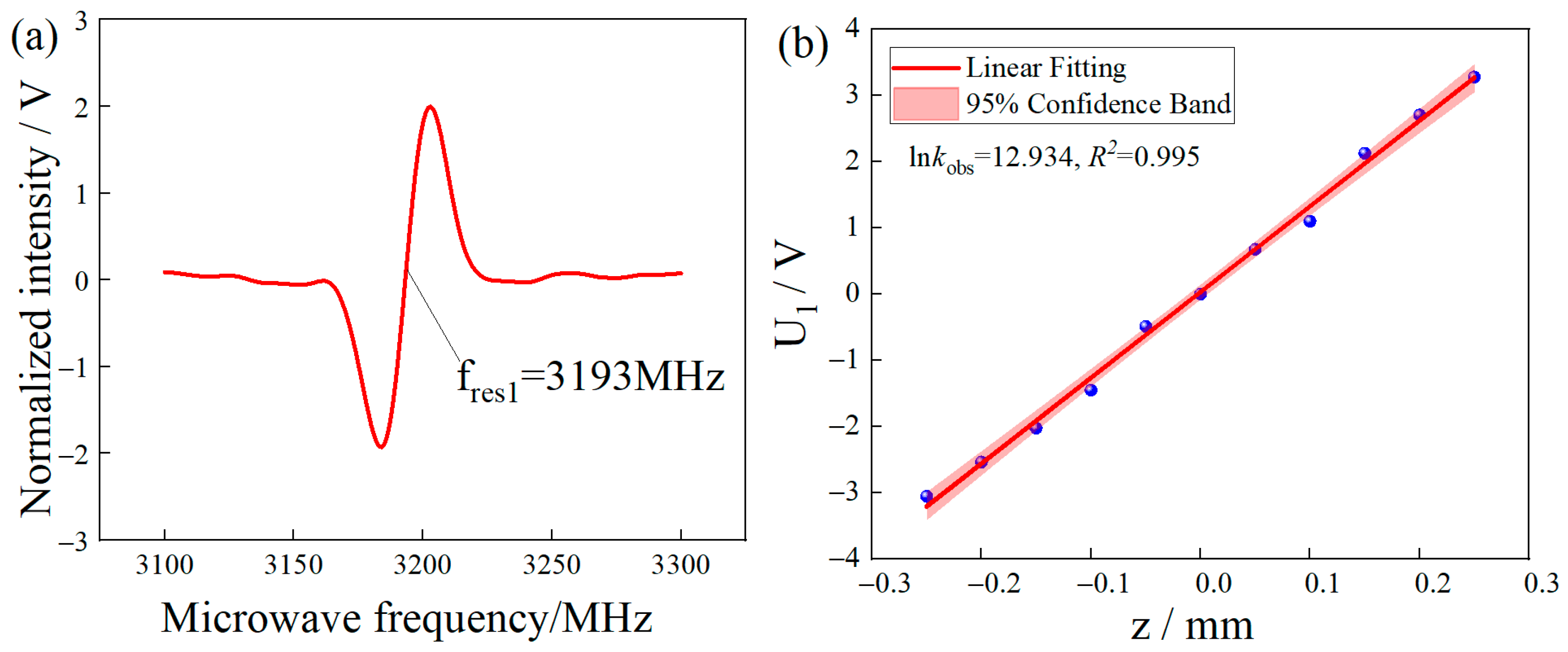
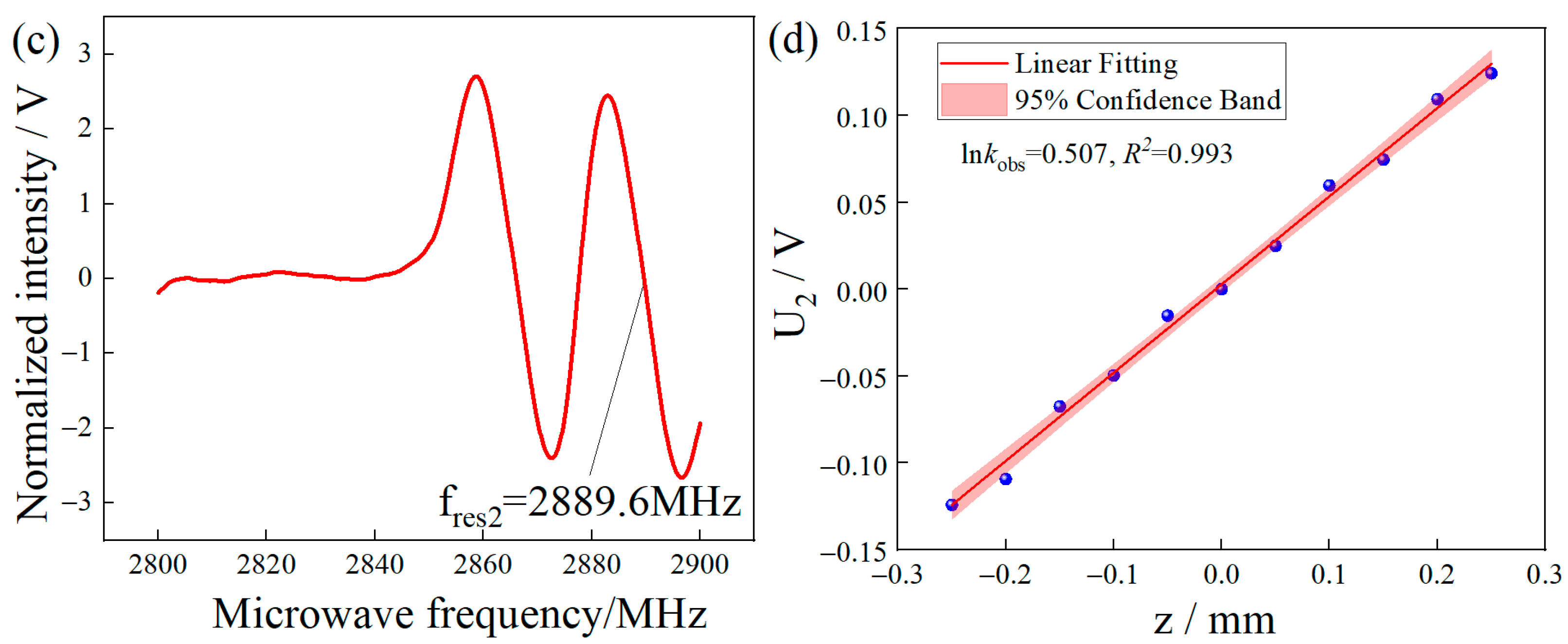
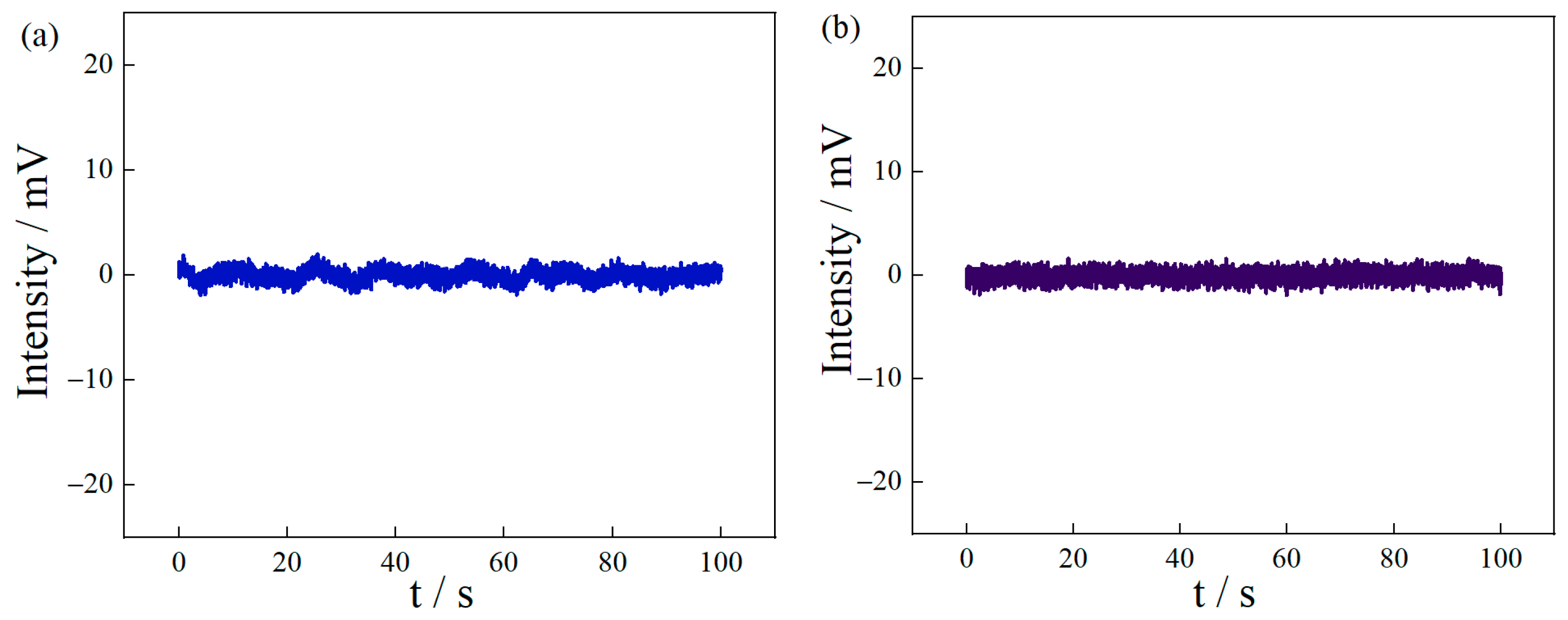
Disclaimer/Publisher’s Note: The statements, opinions and data contained in all publications are solely those of the individual author(s) and contributor(s) and not of MDPI and/or the editor(s). MDPI and/or the editor(s) disclaim responsibility for any injury to people or property resulting from any ideas, methods, instructions or products referred to in the content. |
© 2023 by the authors. Licensee MDPI, Basel, Switzerland. This article is an open access article distributed under the terms and conditions of the Creative Commons Attribution (CC BY) license (https://creativecommons.org/licenses/by/4.0/).
Share and Cite
Liu, Y.; Li, Z.; Zhang, H.; Guo, H.; Shi, Z.; Ma, Z. Research on Micro-Displacement Measurement Accuracy Enhancement Method Based on Ensemble NV Color Center. Micromachines 2023, 14, 938. https://doi.org/10.3390/mi14050938
Liu Y, Li Z, Zhang H, Guo H, Shi Z, Ma Z. Research on Micro-Displacement Measurement Accuracy Enhancement Method Based on Ensemble NV Color Center. Micromachines. 2023; 14(5):938. https://doi.org/10.3390/mi14050938
Chicago/Turabian StyleLiu, Yuqi, Zhonghao Li, Hao Zhang, Hao Guo, Ziyang Shi, and Zongmin Ma. 2023. "Research on Micro-Displacement Measurement Accuracy Enhancement Method Based on Ensemble NV Color Center" Micromachines 14, no. 5: 938. https://doi.org/10.3390/mi14050938





